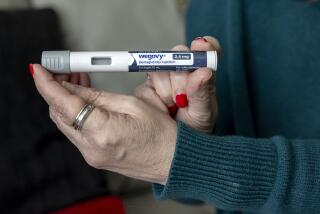Women Get Tips on Sidestepping Heart Disease : Health: Cardiovascular illnesses tend to claim females 10 years later in life than males. Diet and estrogen-replacement therapy can reduce risks.
CHICAGO — Heart disease may be an equal-opportunity killer of women and men, but women need different strategies to elude it, starting with their knowledge of the enemy.
“Most women, if you ask them what’s their single biggest disease risk, they’d say breast cancer. They don’t realize how important cardiovascular disease is,” says Dr. Robert D. Langer of UC San Diego’s School of Medicine.
“It dwarfs breast cancer and all cancers,” he says.
Cardiovascular diseases, including heart disease, kill 500,000 women and 475,000 men yearly, the American Heart Assn. says. The figures are based on 1988 data, the latest available.
Breast cancer by contrast killed 42,200 women in 1988, and lung cancer claimed 46,400 more.
While cardiovascular diseases tend to claim females about 10 years later in life than males, 23,000 women under 65 died from them in 1988, and more than a quarter of those women were under age 55.
Menopause is the great divide for women in terms of cardiovascular danger. Before menopause, death rates from heart disease, strokes, high blood pressure and related ailments remain relatively low. Afterward, those death rates zoom up because women lose the protective effect of the hormone estrogen.
Many women fail to appreciate that, says Dr. Mary Ann Malloy, a professor at Loyola Stritch School of Medicine and organizer of the American Heart Assn.’s first conference on heart disease in women, in 1989.
“I think women see all the other implications of menopause,” says Malloy, also a practicing cardiologist.
Women’s hazard of cardiovascular death rises more than fivefold between ages 34 and 44, another fivefold during the next decade, and fourfold more the following decade.
Estrogen-replacement therapy can dramatically reduce an individual woman’s risk, but whether all women should get it and whether estrogen alone is sufficient is still being researched.
“The state of the art (on hormone replacement) varies from woman to woman and doctor to doctor,” says Trudy Bush, associate professor of epidemiology and gynecology-obstetrics at Johns Hopkins Medical Institutions in Baltimore.
Estrogen replacement confers “a remarkable protective effect” against heart disease death--a 40%-60% reduction in risk compared with post-menopausal women who don’t take it, Bush noted. But estrogen replacement also increases the likelihood of developing cancer of the womb lining.
That increase can be canceled by adding the hormone progestin, a synthetic version of progesterone, also lost after menopause. But progestin has possible side effects such as depression, mood swings and undesirable changes in breast tissue. It also may slightly increase breast-cancer risk.
Many other cardiovascular prevention measures should be higher on women’s minds than estrogen replacement, starting with quitting tobacco, say Bush and Langer, both researchers into hormonal replacement.
“Smoking is far and away the most important risk factor. Nothing comes close,” Langer says.
Bush agrees: “Women who smoke like men die like men who smoke. That’s my public message for the day.”
One in 4 U.S. women smokes, and every day, more than 1,600 teen-age U.S. girls smoke for the first time, the World Health Organization said recently.
Smoking boosts women’s risk of cardiovascular death proportionally more than it does men’s, probably because women start with lower risk, Langer says.
Second in importance to quitting smoking is keeping blood pressure within normal limits and getting treatment if it is elevated, he and Bush say.
Third is keeping blood-cholesterol levels within a safe range and fourth is eating a diet lower in fat than the current U.S. average of 38% of total calories consumed, Langer says.
“Cholesterol is important, particularly in the face of a family history of cardiovascular disease, but probably less important than smoking and blood pressure,” he says.
“Diet is very important in women, not only in terms of preventing cardiovascular disease, but also breast cancer and colon cancer,” he adds.
Scientists disagree over whether it is sufficient to lower fat to the heart association’s recommended 30% of total calories consumed, and Langer says it probably depends on the individual.
For someone with a family history of heart disease, fats should comprise no more than 20%, he says.
Other physicians, such as Dr. Dean Ornish, director of the Preventive Medicine Research Institute at UC San Francisco, say an optimum diet contains no more than 10% of calories from fat.
“Women often respond better than men” to such a diet, as well as to cholesterol-lowering medications, says Ornish, author of the 1990 book “Dr. Dean Ornish’s Program for Reversing Heart Disease.”
Fifth in importance for women to head off cardiovascular disease is knowing if they are diabetic, and controlling it if they are, Langer says.
Dr. Renee S. Hartz, chief of cardiothoracic surgery at the University of Illinois Hospital and Clinics, says that overall, preventing heart disease may be more important for women than for men, since women have poorer one-year survival after heart attacks and die at higher rates during bypass surgery.
“Women (traditionally) had their gynecologist, and as long as they felt they had a doctor, that was OK. But that’s not OK,” Hartz says. For heart-disease prevention, women need the care of an internist, or a personal physician in general practice or family practice, well before menopause, she says.
“Be responsible for your own health, and if you really feel there’s something wrong, something wrong in your chest or you’re worried about your family history, get an internist even earlier,” she says.
“And if the internist ignores you, get a different one.”






